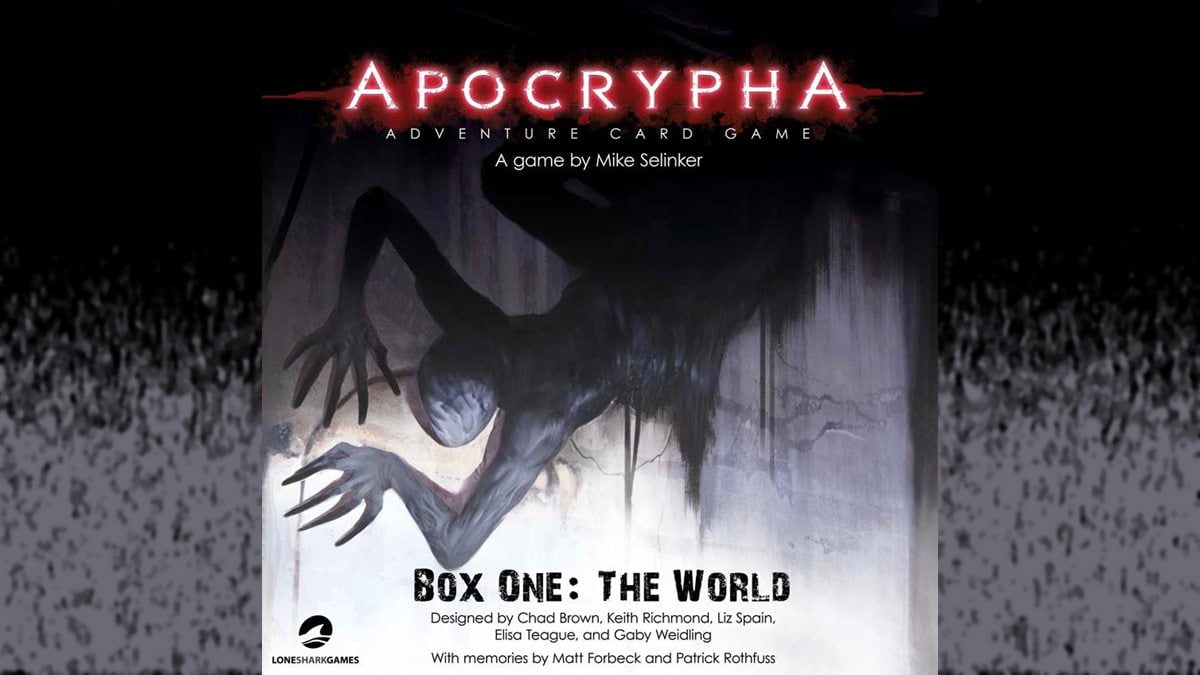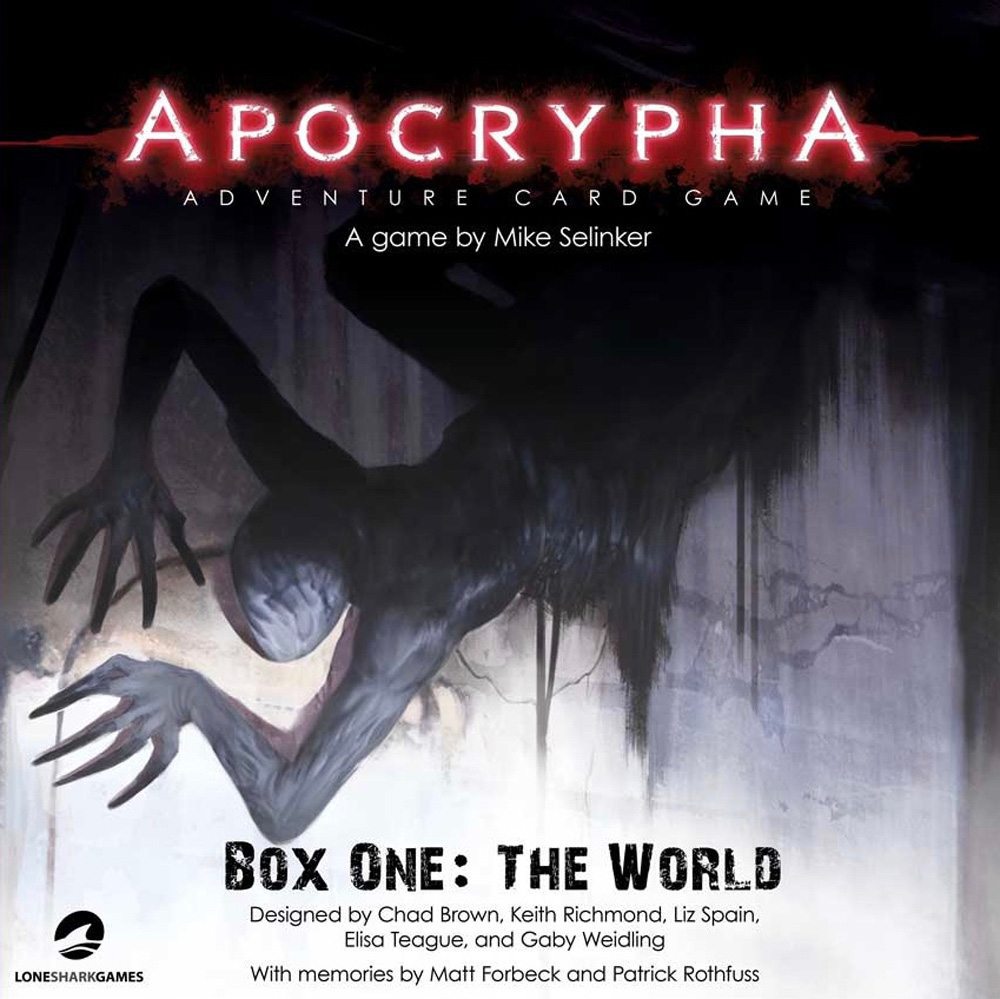The world isn’t what it seems—but only a select few can see beyond the veil to the true horrors that exist. In the Apocrypha Adventure Card Game, you and your fellow “saints” must fight against the novem, powerful beings trying to bring about an apocalypse.
What Is the Apocrypha Adventure Card Game?
Apocrypha is a cooperative adventure card game for 1 to 6 players (up to 7 if using the guided roleplaying mode), ages 12 and up, and takes about an hour per mission. It retails for $74.95 and is available from retail stores and from the Penny Arcade store, as well as other online retailers. The game’s mechanics are similar to the Pathfinder Adventure Card Game (though with some significant differences), and it has a horror theme. I think experienced younger players would be able to learn the mechanics, but the theme may be more of a factor in deciding whether it’s appropriate for them.

Apocrypha Adventure Card Game Components
The base set of Apocrypha is called The World, and comes with the base components as well as the first chapter, known as “The Book of the Skinwalkers.” Additional planned expansions will include more chapters, but you’ll need the base game to play.
There are 486 base cards:
- 7 player aids
- 9 Saints
- 48 Fleeting Fragments
- 40 Deaths
- 34 Nexuses
- 5 Mutations
- 60 Omens
- 44 Mind Gifts
- 44 Body Gifts
- 44 Soul Gifts
- 44 Rage Gifts
- 45 Threats
- 21 True Threats
- 9 Missions
- 13 Structures
- 3 Master Archetypes
- 16 Minion Archetypes
In addition, there are 98 cards from “The Book of the Skinwalkers”:
- 1 Saint
- 3 Nexuses
- 4 Mutations
- 9 Omens
- 9 Mind Gifts
- 9 Body Gifts
- 10 Soul Gifts
- 10 Rage Gifts
- 15 Threats
- 17 True Threats
- 11 Missions

Finally, the base set also includes:
- 10 Saint standees
- 6 plastic bases
- 20 dice (4 each in red, blue, green, purple, white)
- Rulebook
- Storybook for “The Secrets of Candlepoint” and “The Book of the Skinwalkers”
As you can see, the game is primarily a card game, with a handful of dice. The dice, unlike the Pathfinder Adventure Card Game, are standard six-sided dice, so you won’t be using your polyhedral dice in this game. The characters are cardboard standees with plastic bases—there are only 6 bases, since you will only have up to 6 characters in play at any given time.
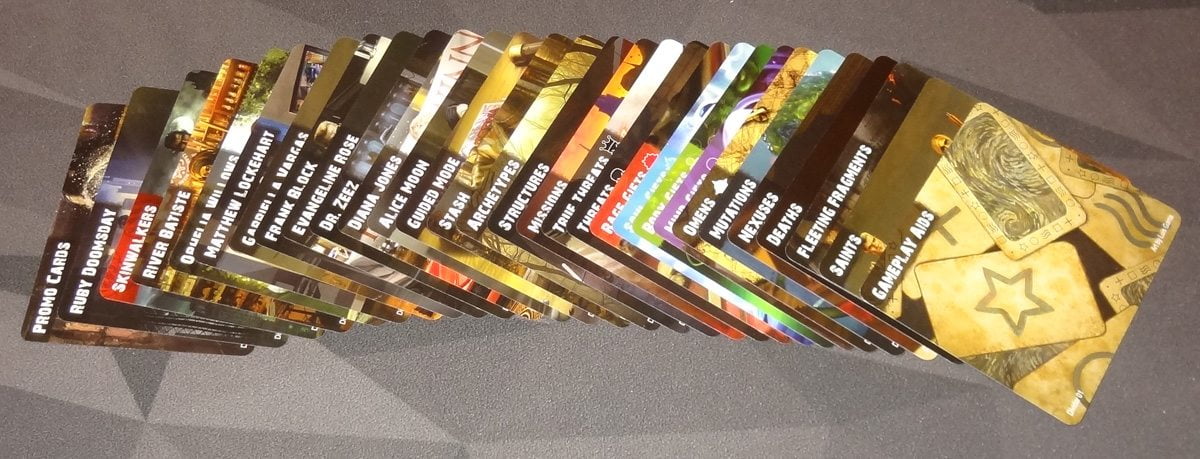
The card quality is decent, nothing really exciting. The artwork on them is great, though, with a lot of dark humor throughout in the illustrations, the titles of the cards, and the flavor text. Most of the card powers use a set of icons, allowing the text to be shorter—but you may find yourself referring to the player aid frequently until you get used to what everything means.
The fragments represent lost memories, and you gain them as you complete missions. Each one has a special ability associated with it, and also includes a tiny short story. The base game includes memories written by Patrick Rothfuss, Mike Selinker, Matt Forbeck, Liz Spain, Gaby Weidling, and many others, and it’s a lot of fun to read them as they appear in the game.
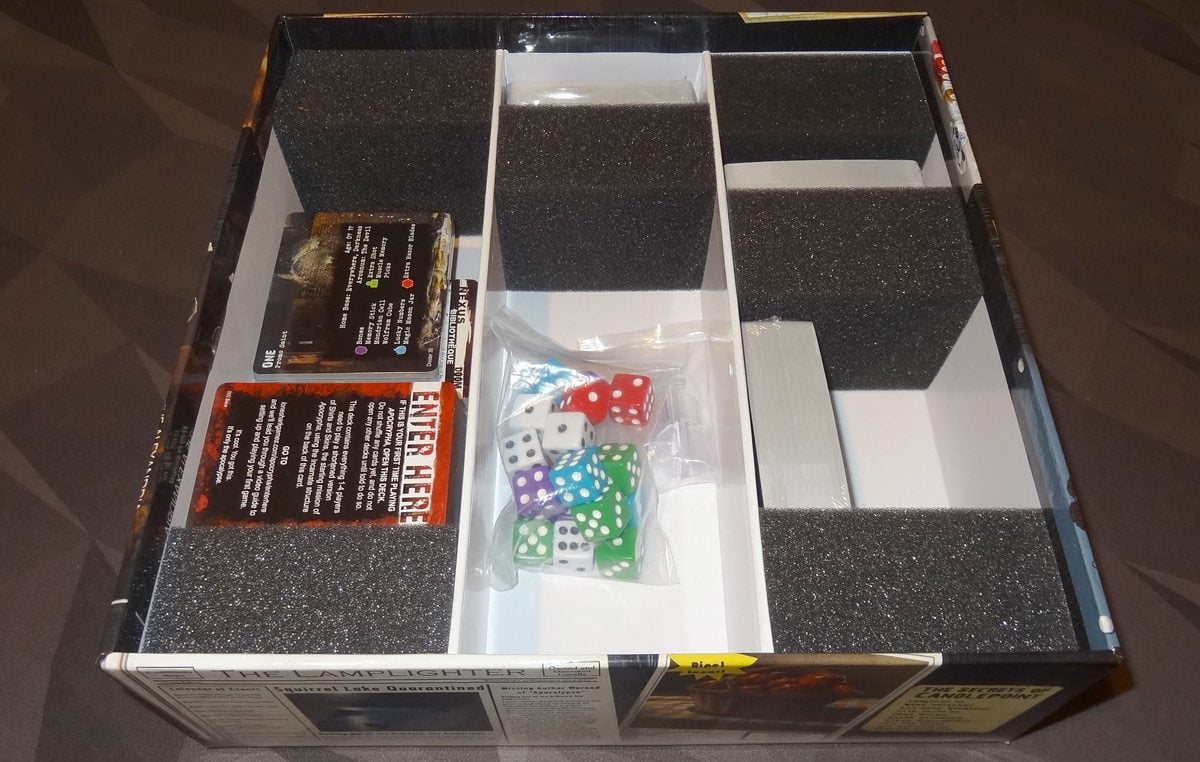
When you first open the box, you’ll find the various bricks of cards and card dividers, plus a lot of empty space and some foam blocks for spacers. There’s more space than necessary for the base game, but that’s because of the content that is still to come.
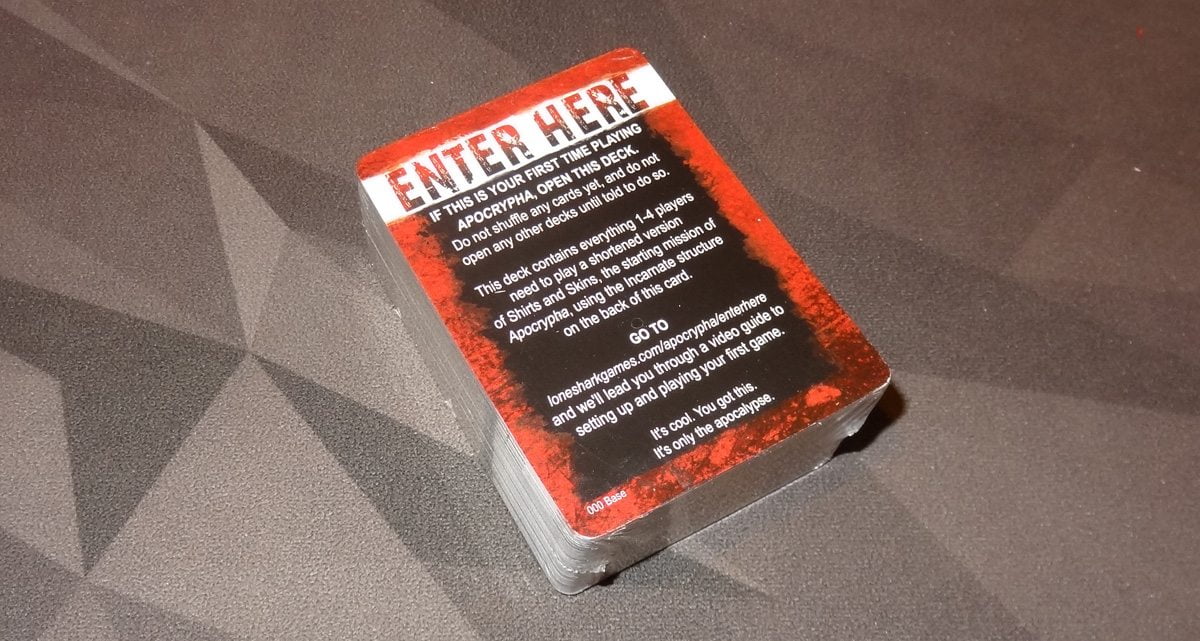
Apocrypha also comes with a handy “Enter Here” deck—one of the card bricks has a tutorial mission for 1 to 4 players already sorted out and ready to play. It’s a shorter version of the first mission, “Shirts and Skins,” and you can visit the Lone Shark Games website for a video on how to set up and play.
If you’re already familiar with the game, you’ll need to sort out these cards into their proper places.
How to Play the Apocrypha Adventure Card Game
You can download a copy of the rulebook here. If you’re familiar with the Pathfinder Adventure Card Game, there are a lot of similarities … and a lot of differences. I’ll give a summary of the differences down below in a separate section.
The Goal
The goal of the game varies from mission to mission, but usually involves tracking down some sort of threat and dealing with it before time runs out.

Setup
First, each player chooses a saint to play. When you first begin, you will have some basic starting cards that match your virtues, but as the game progresses you may be able to trade those out for other cards that you acquire, and you’ll continue to use the same deck for that saint. Each saint’s character card shows the four “virtues” along the edges of the card, and those are the cards you will have in your deck, along with a number of omens. Your hand size is also listed on your character card, as well as some powers.
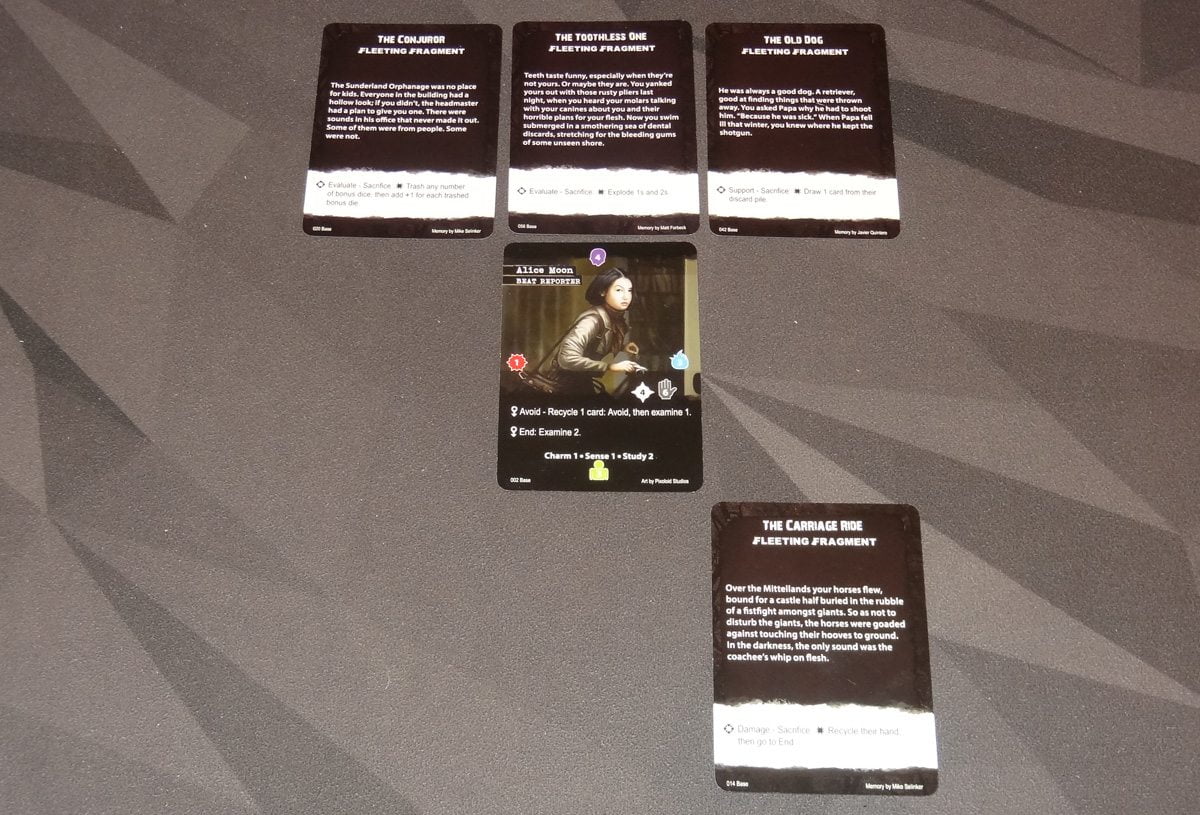
You may also have some fragment cards if you’ve completed any missions—these are placed in the eight spaces surrounding your character card, which are called slots in your “halo.” The position of these cards is important, but we’ll get to that later.
Each player shuffles their own deck of cards, and draws a hand of cards.

Next, you’ll need to pick a mission to play. The game is designed so you can play the missions in any order; each “chapter” has its own missions as well as a set of cards to mix in with the base set. The mission’s setup instructions are spelled out in the storybook, which will instruct you on which structure cards to use. For instance, in the above mission “No Way Out,” the mission is “Cleanse the Dust Bunnies Wherever There’s Trouble as the Hours Pass.” That means you’ll need the structure cards for “Cleanse,” “Wherever There’s Trouble,” and “As the Hours Pass.” The setup rules also indicate that you need the Dust Bunny and the Hay Man true threat cards. Together, the structure cards and the storybook tell you how to assemble the nexus decks and the clock deck, along with other rules that may determine where players will start or how they can move from one nexus to another.
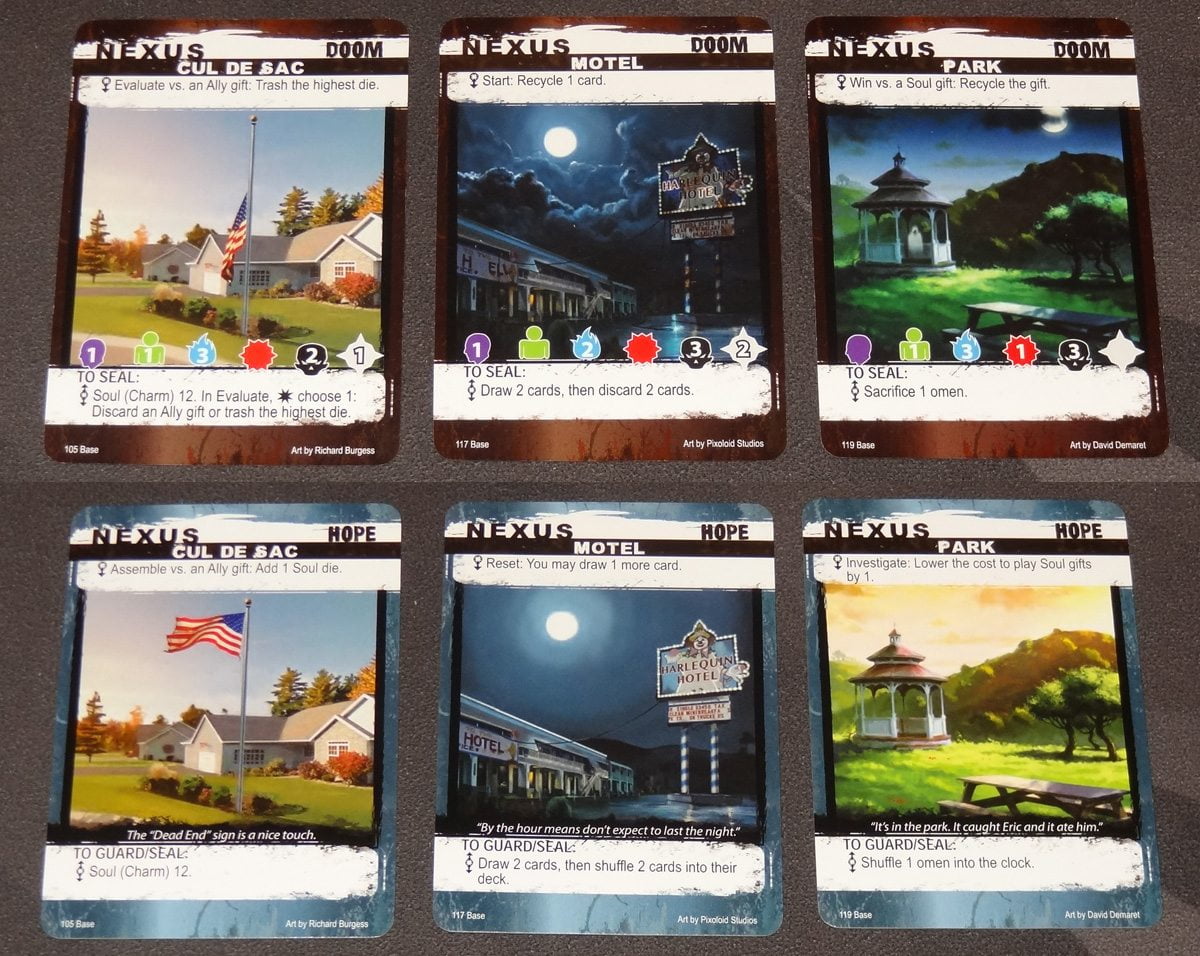
Each nexus card shows a number of icons representing the various card types: Mind, Body, Soul, Rage, Threat, and Omen. You’ll build the nexus deck using the indicated number of cards, randomly drawing from each of those card types and shuffling them together. The structure cards will also indicate whether to shuffle in some other archetype cards that represent the true threats for the mission.

There’s only one card for each type of true threat, so the archetypes stand in for them. For instance, in the “No Way Out” scenario, any archetypes that say Minion 12 through Minion 16 all represent Dust Bunnies.
Typically, you will have a clock deck that consists of a certain number of omen cards, and then some number of nexuses based on the number of players. The structure cards will also indicate where the saints begin—place the standees at those locations.
Set the dice nearby, along with the true threat cards and the mission card.
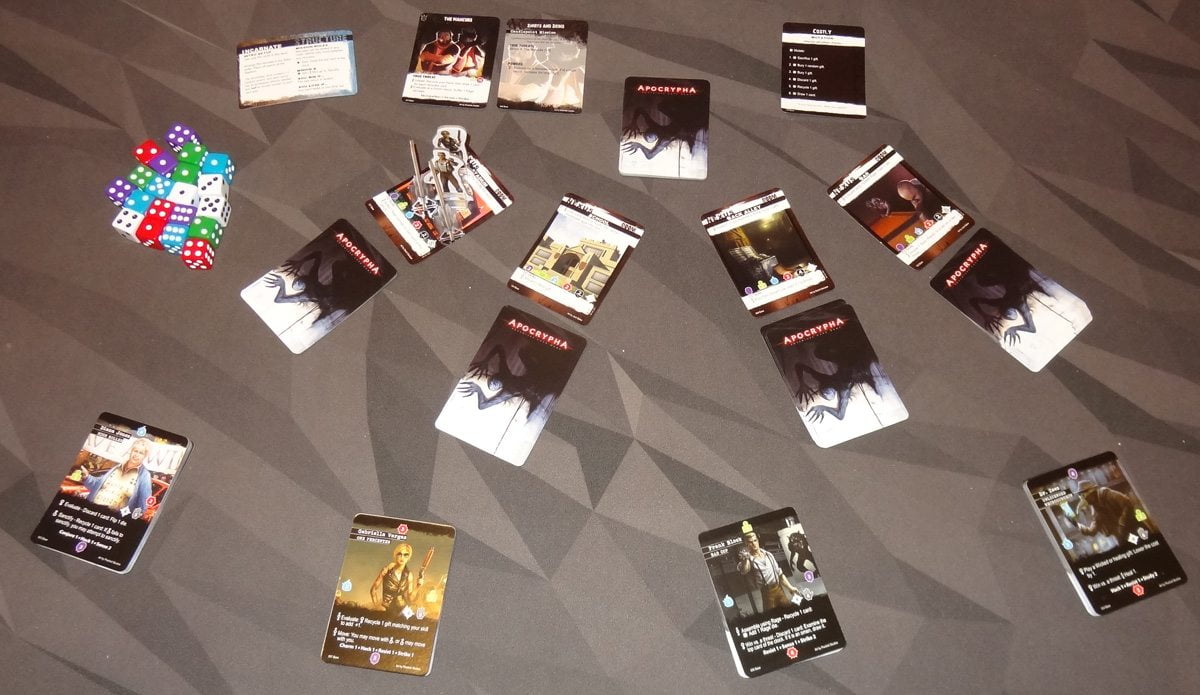
Gameplay
Players choose a starting player, and then turns proceed clockwise. Each turn follows the same structure:
- Start: Draw the top card of the clock deck.
- Support: Players may use “support” powers.
- Investigate: Play an omen to flip the top card of your nexus. Avoid it (if you have that ability) or Confront:
- Initiate: Use powers that happen first.
- Act:
- Target: Choose a virtue (Mind, Body, Soul, Rage).
- Assist: Choose saints to assist you.
- Mutate: Roll a mutation if anyone assists you.
- Assemble: Collect dice for this check.
- Evaluate: Roll and use powers that affect dice, then compare to the target number.
- Damage: Discard cards from your hand if you fail to defeat a threat.
- Terminate: Activate powers that happen last.
- Win: Draw the gift into your hand, or sacrifice the threat.
- Lose: Sacrifice the gift, or shuffle the threat back into your nexus.
- Sanctify: Seal your nexus if it’s empty or you are otherwise allowed.
- Transfer: Move your saint to another nexus or give a card to another saint at your nexus.
- End: Reset your hand.
The Support and Investigate steps may be repeated as many times as you like.
That’s a lot of steps and there are a lot of details, but I’ll just address a few of them here.
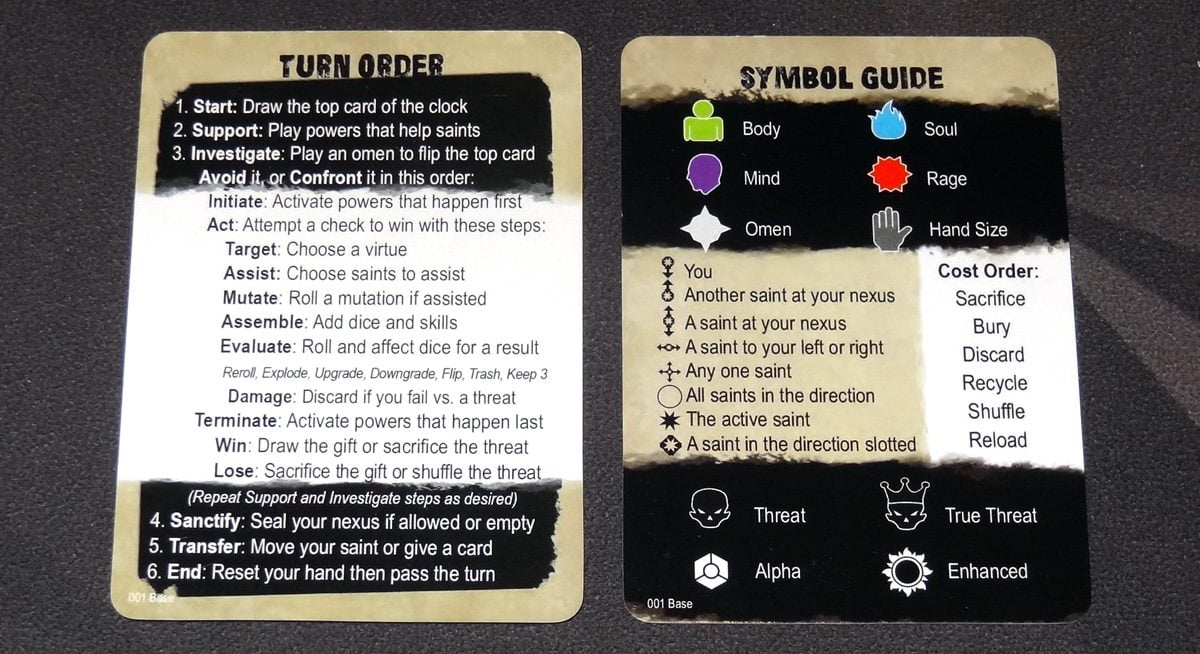
Using Powers
First up: many cards—from cards in your hand to your saint card to your nexus card—may have various powers listed on them, and each power is accompanied by some little symbols that look like a circle with arrows sticking out in different directions, as well as a turn order phase. Those arrows indicate who is affected by the power, and the phase indicates in which phase you can play the card. An arrow pointing down means it affects you. Arrows to the left and right indicate the players who are physically sitting to your left and right. An arrow pointing up indicates a saint at your nexus (not including you). Because of this, your physical placement around the table when you sit down may matter.
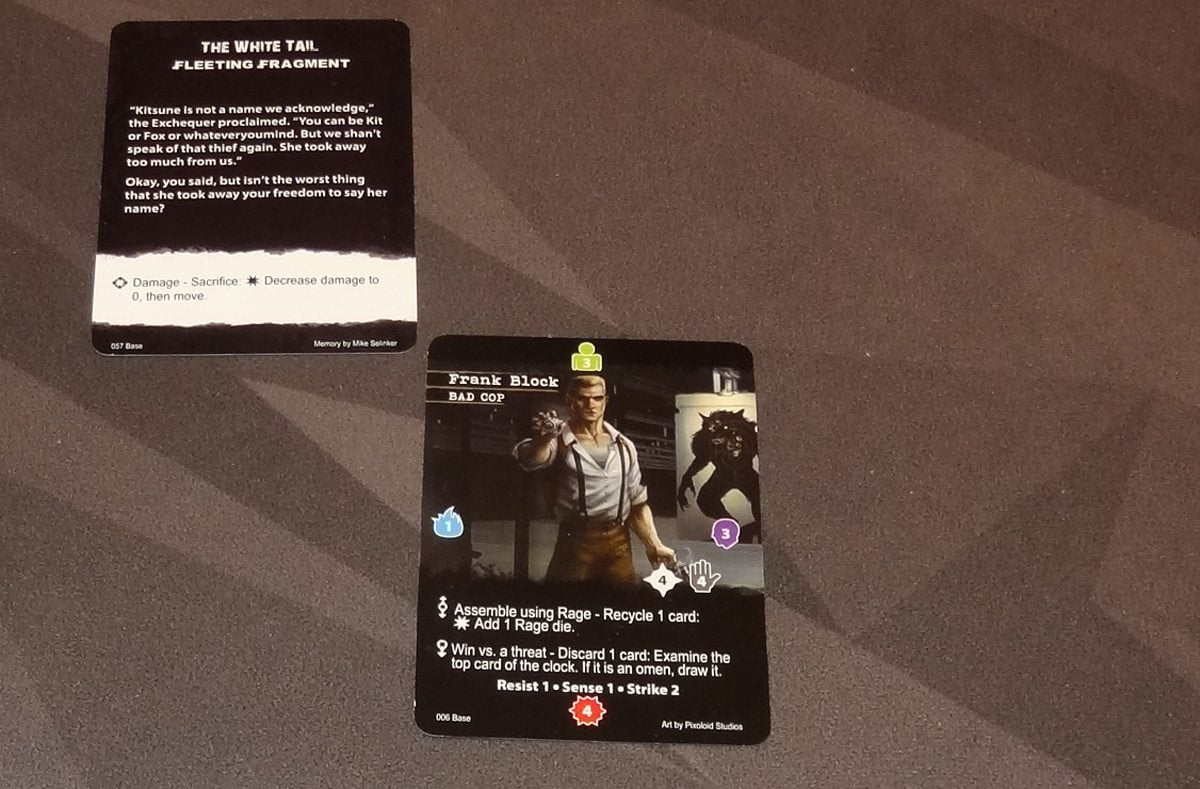
Those directions are also used for other things, like the fragments in your halo. In those cases, the eight slots around your saint card act like the arrows on powers: a card that is slotted above your saint card can be used only for other saints at your nexus; a card that is slotted at the top left of your nexus (like the one pictured above) may be used for another saint at your nexus or the player sitting to your left. Likewise, each of your virtues is listed on one edge of your saint card—that indicates which players you can assist in each of the four virtues. For Frank Block (pictured above), he can assist himself with Rage, the player to his left with Soul, the player to his right with Mind, and any other player at his nexus with Body. (More on assisting later.)

The clock deck is usually made up of omen cards, but depending on the game setup there may be other cards in there as well. Omen cards are basically used only for investigating: each one is either Hope or Doom, and there’s text that indicates what it will do. Generally, omens of hope will give you benefits and omens of doom will inflict penalties. On top of that, it will flip your nexus card to the corresponding side, which has additional effects.

When you investigate, you play an omen card, follow its instructions, and then reveal the top card of your nexus. Cards are either gifts (good things) or threats (bad things), but each one shows two virtues and the target values to win. For instance, the werewolf pictured above requires 11 Body or 14 Rage to defeat—you can’t fight it with Mind or Soul (unless you have particular effects that allow you to do so). You choose one of these virtues to use, and you get as many dice as your saint’s value in that virtue. In addition, there may be some keywords at the bottom of the gift or threat—if any of these match your saint’s keywords, you may also get some bonus dice.

You can also call for assistance from other saints. As described above, a saint can help you with a particular virtue if they’re in the right position, and their assistance is tied to the value of their virtue. The assistance will allow you to re-roll that many dice. So if Frank Block assists you with Mind, he will allow you to re-roll 3 dice. But if he assists with Soul, he will only allow you to re-roll 1 die, which is not as helpful.
And there are risks associated with assistance. If anyone agrees to assist you (including yourself), the encounter mutates. Draw a random mutation card, and flip it to the side that matches your encounter (threat or other). Then roll a die, and check the chart. Quite often, the mutation will make it harder to win, though rolling higher is generally better. Note that the encounter mutates as soon as the saint agrees to assist you—even if you don’t end up re-rolling any dice.
Finally, you assemble all your dice. There are four dice of each color, corresponding to the four virtues, plus four bonus dice (white). That’s the maximum you can roll. If you need more dice of a color and there aren’t any, you get bonus dice. If there are no more bonus dice, you don’t get anything else. You roll the dice, manipulating them or re-rolling them as your powers allow. Then, you choose up to three of the dice for your final result.

Compare your result to the target—if you match it or exceed it, you win. Otherwise, you lose. For a gift, you’ll either put it in your hand or sacrifice it (putting it back in the game box). For a threat, you either sacrifice it if you win, or shuffle it back into your nexus if you lose. In addition, if you lose to a threat, you’ll take damage, discarding cards equal to the difference between your total and the target. You must first discard cards matching the virtue used in the check; if you don’t have enough of the matching virtue, you’ll discard random cards instead.
After your encounter, if your deck is empty, or if some power allows you to sanctify, then you can attempt to seal your nexus. Quite often (but not always), if you defeat a minion, you’ll be able to sanctify—this is usually indicated on the mission card. Each nexus has its own rules for sealing, and they’re easier on the Hope side than the Doom side. You may be required to perform a particular check, or sacrifice a type of card. If you succeed, you remove all the cards from the nexus except any master archetypes. If there’s nothing left, the nexus card is removed as well, and all the saints move immediately.
A nexus is also automatically sealed if you defeat a master there, but the master will have a chance to escape to another nexus. Before fighting a master, other saints may guard their nexuses, following the “seal” requirements to temporarily seal off the nexus. You do not empty the nexus deck in this case, you just don’t allow the master to go there.
At the end of your turn, you reset your hand to get back to your saint’s hand size. If you ever have to draw cards and you don’t have enough, your saint “fades”—it’s kind of like death, but not quite. You display a Death card next to your deck, and you continue to take turns. If the team wins the mission, you may be able to avoid death, but if the team loses, at least one saint will add a Death card to their halo, which takes up space that could otherwise be used for fragments. If you ever need to slot a ninth Death card, the saint is dead forever.
Game End
The game’s end depends on the mission setup, but typically you’ll have to achieve a victory condition before the clock deck runs out. Often, the victory condition will be trapping and defeating a master, but there are a number of other types of missions that may involve collecting a certain number of minions or closing all the nexuses. There are some missions where you’ll fail if any saint fades.
In between missions, you reset your saint’s deck—players may freely trade cards that were acquired during the mission, but you’ll need to end up with the numbers of each virtue as indicated on your saint card. If there aren’t enough cards of the right type, you can take starting cards from those types. Also, if you successfully complete a mission, each saint will earn a fleeting fragment. There’s one printed on the back of the mission card, and you also draw some random fragments from the box.
Guided Play
Apocrypha can also be played as a role-playing game, with one person leading the adventure like a DM. It gives the guide more flexibility in choosing the order in which players will encounter threats and gifts, as well as other things like the order that they visit nexuses and so on. I have much less experience playing RPGs, so I stuck with the card game version myself.
Comparing the Pathfinder Adventure Card Game and Apocrypha
As I mentioned in my original Kickstarter alert for Apocrypha, there’s a significant overlap between Apocrypha and the Pathfinder Adventure Card Game. Mike Selinker had been working on a game (then called Saints) that eventually became PACG. But he always wanted to revisit the universe he had created for Saints, and he also had some ideas for mechanics that would be hard to fit into PACG‘s system.
So there are lots of similarities, though the terminology has changed. First, here’s a quick rundown of terminology that differs from one game to another:
| Apocrypha | PACG |
| Saint | Hero |
| Investigate | Explore |
| Gift | Boon |
| Threat | Bane |
| Omen | Blessing |
| Virtue | Skill |
| Nexus | Location |
| Seal | Close |
| Master | Villain |
| Minion | Henchman |
| Mission | Scenario |
| Chapter | Adventure |
There are many differences, but here are a few that stand out:
- You don’t get a free “explore” each round; instead, you must spend an omen for each time you want to investigate, but you do draw the card from the clock deck into your hand, which is usually an omen.
- Movement happens at the end of your turn, and you can move or give a card, but not both.
- Each nexus has a Hope side and Doom side, with different effects.
- There are only 6-sided dice, and they are limited in quantity.
- When you roll dice, you only get to keep up to 3 of the results.
- Seating position around the table matters for more than just turn order.
- Powers are more specific about which saints they affect.
- No limit to the number of cards you can play on a single check.
- More variety in the types of missions and mission goals.
- Option for guided play, making it more of a traditional RPG than an adventure card game.
- Horror theme rather than fantasy theme.
- Cardboard standees instead of token cards representing your character at its location.
- Missions designed to be played in any order.
- Your character’s deck does not increase in number; rather, leveling up is done more through getting better cards and fragments in your halo.
My group had a lot of experience playing PACG, having played through nearly all four of the sets before diving into Apocrypha. It’s hard to say whether that prior experience made learning Apocrypha easier or harder, as we were used to a lot of the concepts but had to unlearn a lot of habits from PACG as well.
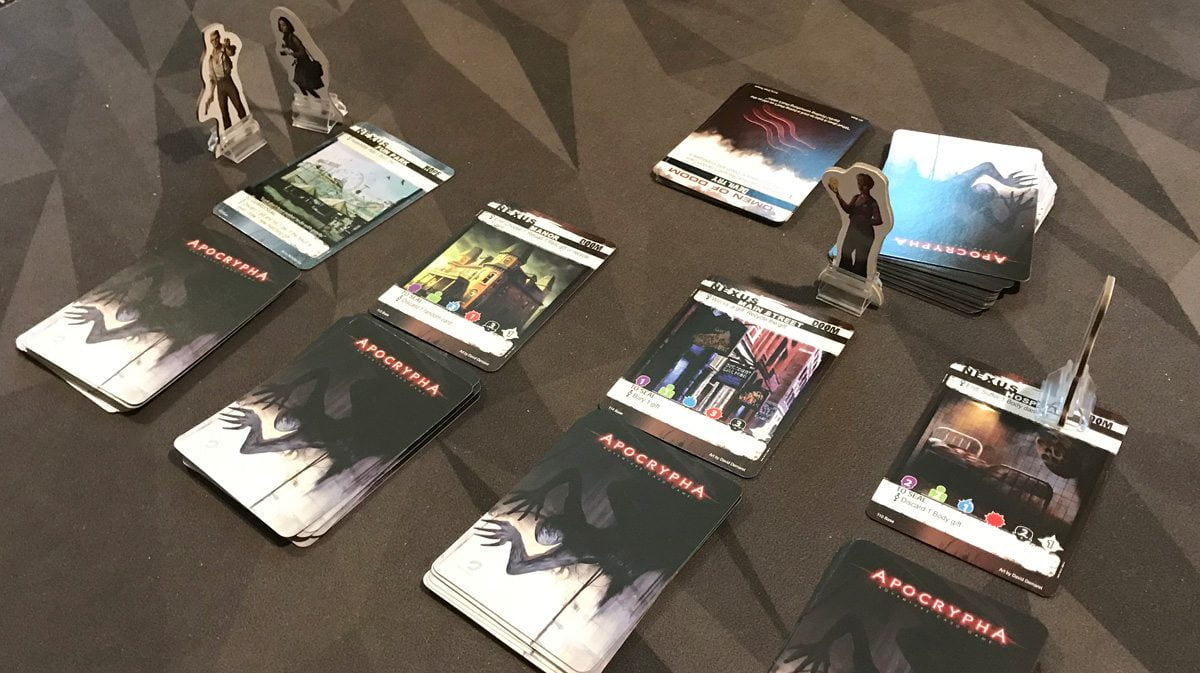
Why You Should Play the Apocrypha Adventure Card Game
Mike Selinker and the Lone Shark Team basically invented this thing called the “adventure card game,” which is a sort of mash-up between a role-playing game and a card game. It has a little bit of deck-building involved, but that deck-building is more like a slow process of evolution rather than a rapid development as in a game like Dominion. There’s more of a focus on story than in some card games, but it can also run itself without the need for a game master as in a traditional RPG. I fell in love with the Pathfinder Adventure Card Game when it first came out, and my party of five has adventured through goblins, pirates, demons, and mummies in the past five years.
But before all of that, I remember playing a prototype of Saints at a local gaming convention years and years ago, when I’d first met Mike Selinker for the first time. I had already discovered that I liked deck-building games, and I’d heard that he was running playtests of a cooperative deck-building game. At the time, it also had some legacy-style elements—envelopes for each deck with stickers and so on—and I was quite intrigued even then. So it’s quite exciting to see this game in its finished form, with artwork and crazy back stories and creepy fragmented memories.
I’ll admit that I’m generally more of a fan of fantasy than horror. That’s one of the things that made PACG an easy sell: even though I didn’t know the world of Pathfinder specifically, it has enough of the typical “swords and sorcery” stuff that I was able to follow along easily. Apocrypha digs into things like vampires and werewolves, plus the more vague fear of the unknown. It’s a world in which there are monstrous things but most of the population simply cannot see them—but you can, and it’s up to you to hold off the apocalypse. But despite my general attitude toward horror, I did find a lot to like thematically about Apocrypha, particularly in the way that there’s humor woven throughout, sometimes just in the name of an item, sometimes in the illustration, sometimes in the flavor text. That said, I think the overall theme (particularly some of the short stories on the fragments) may make this inappropriate for younger players—I encourage parents to skim through the game before introducing it to their kids.

The Lone Shark team did learn a lot of lessons from PACG, and that helped streamline this game somewhat. The powers and their effects are more codified, and the turn order has specific named phases that are repeated on card effects to make it more clear when cards can be played. The iconography with the arrows takes a little getting used to—mostly because you have to remember to look at them—but it does make sense once you get used to it, and saves on a lot of text. One logistical change is the introduction of the archetypes for masters and minions—in PACG, you’d wind up with a huge stack of henchman cards, because you might need as many as 6 of the same monster, even if it was only used in a single scenario. Apocrypha has a clever fix by using generic master/minion cards so that you only need one of each true threat, no matter how many of them might appear in the mission. It’s a small tweak that will save on a lot of cards over the course of the entire game.
Still, Apocrypha can be tricky to learn. There are a lot of details that are easily missed, and I still find myself checking the FAQ and scouring BoardGameGeek forums when I have questions. One complaint I have in particular has to do with the mission setup. There’s a mission card and structure cards, but you still have to refer to the storybook, because the cards themselves don’t list the nexuses you’ll need for the mission. More importantly, there’s often a few lines in the storybook that provide additional setup instructions specific to the mission—this is what I most often miss. It’s a weird way to split up information between cards and a thick rulebook, so that you can’t really make do with just one or the other.
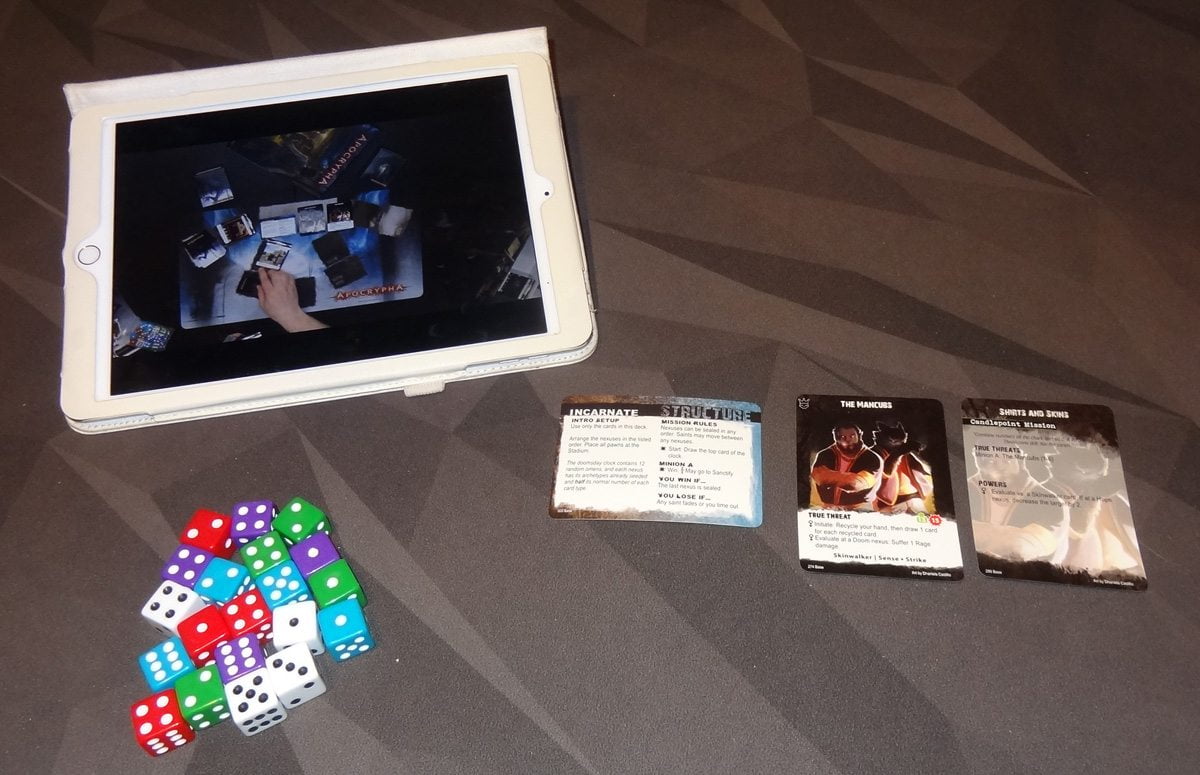
I did appreciate the “Enter Here” deck as a starting scenario, and even though I had played Apocrypha demos at conventions I decided to start with that for my first game with my own group. (The downside is that we usually have five players and this demo is only for four saints.) I’m not a huge fan of watching videos so it would have been nice to have a written version of the instructions as well, but it worked fine, and after that we were able to move onto the full games.
There is an Apocrypha companion app that includes card galleries so you can look up any card and see it on your smartphone, and you can also create play groups to store information about each saint, what’s in their decks, which mission you’re playing. However, I haven’t found that particular part to be very useful, because it requires a lot of data entry after each mission, whereas the information is already physically stored in the form of the saint decks in the box. It’s also not entirely clear to me where the mission log is, if any—I can select “win” or “lose” after playing the mission, but I don’t see how that affects anything in the app.

The one thing that is kind of fun is the temporal mutation shown on the home screen of the app. Basically, it’s a power that is only in effect on that particular day. For instance, the Gaby’s Saint Name Day temporal mutation gives the saint Gabriella Vargas a boost to her power. Other mutations may affect saints in good or bad ways. If you like adding random little tweaks to the scenarios, this is a fun way to do it. Otherwise, though, the app isn’t quite as useful as I’d hoped it would be.
As far as the gameplay goes, I really like that it’s not just PACG with a horror theme. It has enough differences (see above) that it’s not just a reskinned game, but is actually its own game, albeit in the same family. One of the biggest differences is with the dice: you can only get so many dice during a check, and even then you’re only going to keep three of them. In PACG, the numerical value of checks ramped up significantly over the course of the game because players would increase in skill, allowing them to add to their dice or roll more dice—it wasn’t uncommon for us to roll a huge handful of dice against the final villain. In Apocrypha, more dice simply means more options, but it doesn’t raise your maximum possible result, which is 18 (unless you have powers that add to the value).
I also like the risk/reward balance when asking your fellow saints for assistance, particularly since that assistance comes in the form of re-rolls, which aren’t guaranteed to improve your situation. Do you risk the mutation so that you can re-roll dice if you fail the check? That may mean that you make the check even worse and still fail it. In PACG, it was often very easy to say, “well, sure, let me throw some more cards to help you” but in Apocrypha that assist action becomes more fraught with uncertainty.
I also like the variety of the missions. As with PACG, there are a lot of “hunt down the big bad” missions, but even then they have slightly different structures: you might have to close the nexuses in order. You might have extra minions in some locations. There are some missions that have no master, and the minions instead have mission-specific powers. Despite my complaints about the setup cards and book, there is more variety in the type of missions. We always looked forward to those when playing PACG and I like that Apocrypha mixes it up a little more.
So, is Apocrypha for you?
I think it’s still best for a fairly consistent group, where you have the same players playing the same characters each time, even though it’s designed in a way that you could have players drop in and out from mission to mission. It simply means that you don’t have the continuity of story if you have a lot of turnover between games—besides the fact that it may be harder for players to learn the game and get familiar with their character’s powers and cards if they’re only playing every other session. It’s the sort of game that I think benefits greatly from having the same party, even if it’s not strictly required. Because of that, it’s not going to be the sort of game I’ll break out at just any game night—it’s more of a scheduled event for me, where I get together a particular group to play through it.
That’s a shame, though, because it is the sort of game I’d like to be playing more. I’m intrigued by the story, and I want to get better at the game, and also see what happens when we start digging into the other chapters. So far we’ve played almost all of the base set missions but not the included “Book of the Skinwalkers” chapter, and I’m curious how the game will feel once we mix those cards in.
It also should go without saying that you have to like the theme. If you just don’t care at all for horror, humorous or not, then Apocrypha is probably just not going to appeal to you.
And, finally, you have to have patience to wade through a lot of rules. It definitely helps if you have somebody who likes poring over rulebooks and looking up answers. Fortunately, my PACG group has been playing together for long enough that we’ve gotten used to doing a little research when needed, or just making a ruling on something as a group to keep the game moving when we can’t find an answer.
If anything, the biggest obstacle to Apocrypha, ironically, is the success of PACG. It seems that I only have room in my life for one campaign at a time. For the past few years, it’s been PACG, which is also the reason I haven’t really delved into other campaign-based games (like Shadows of Brimstone, Gloomhaven, or even Pandemic Legacy) as much as I’d like to. For Apocrypha, my PACG group decided to take a break from Mummy’s Mask to try it out, but we’ll probably try to go back and wrap up Mummy’s Mask now, and then return to Apocrypha after that. I suppose there may be many players who might be more intrigued by the world in Apocrypha than Pathfinder, in which case this may be just the game they’ve been waiting for.
Lone Shark Games is currently working on the other two boxes, The Flesh and The Devil, which will fill out the rest of the Apocrypha story. It may take me a while, but I definitely plan to investigate my way through this entire world they’ve created!
For more about Apocrypha, visit the Lone Shark Games website!
Click here to see all our tabletop game reviews.
If you’d like to stay up-to-date with all of our tabletop gaming coverage, please copy this link and add it to your RSS reader.
Disclosure: GeekDad received a copy of this game for review purposes.
